Ginger Simpson's Blog, page 75
September 18, 2014
GIVE THE FACTS BY RITA KARNOPP
 Let’s face it, we write about subjects that interest us. I love mystery, gold panning and anything to do with Native American heritage. What do I write? Suspense, stories about Montana gold and of course as many books as I can that share the heritage and ways of the Native Americans on the plains in the 1800s. I spend hours scouring through my books and the internet for exciting, new, quirky details to make my stories as ‘special’ as they can be.
Let’s face it, we write about subjects that interest us. I love mystery, gold panning and anything to do with Native American heritage. What do I write? Suspense, stories about Montana gold and of course as many books as I can that share the heritage and ways of the Native Americans on the plains in the 1800s. I spend hours scouring through my books and the internet for exciting, new, quirky details to make my stories as ‘special’ as they can be.But, don’t get too carried away. Just because you love reading page after page on how a Native woman scrapes the hair or fir off a hide, doesn’t mean your readers will.
In my book latest book, Whispering Wind, I described the process of getting married in the Blackfeet culture of 1864 . . . and allowed the reader to learn how it had changed from even earlier times. I used dialog and added humor to make the information feel natural as well as informative.
I wanted the reader to feel the hardships of the gold rush days in Montana.
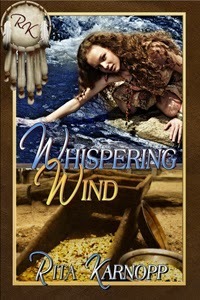 Montana Territory 1865 – Pregnant and alone, Tsopo, Wind, leaves her Blackfoot people to save her lifelong friend, Kom-zit-api, An Honest Man, from untrue accusations.Kom-zit-api finds Wind and asks her to be his sits-beside-him wife. Before she can give him an answer, he dies saving her from Crow warriors. Trapper, Jake McKinney hears her cries and finds her down on a ledge, birthing a child that has arrived too soon. Now Wind finds herself at a crossroads. Ashamed and confused, she accepts McKinney’s offer to go with him to the Big Belt Mountains, where his Confederate war buddies are prospecting for gold. They meet brothers, Tucker and Alexander Walsh on the trail. McKinney, with his valuable bales of furs and buffalo robes, and the Walsh brothers, with their four wagons of supplies, strike a partnership. They’ll start up a general store for miners on the east side of the Missouri River near Diamond City. Wind reveals possession of a gold nugget the size of her thumb. Her father gave it to her, and she knows where in Confederate Gulch it was found. The men make her an equal partner in their business they are now calling Whispering Wind.Nothing like her peaceful village, Wind finds herself among ramshackle clusters of tents, lean-tos, and crude log cabins. The main street is a knee-deep mud trail mixed with horse manure, lined with make-shift stores, hotels, rowdy saloons, and a single assayer’s office. Wind aspires to find love and happiness where greed rules actions above common sense. Dressed like a white woman, hiding her part Blackfeet blood, she faces being one of a few women in a wild, lawless mining territory. Who can she trust? Can she survive where so many men have failed?
Montana Territory 1865 – Pregnant and alone, Tsopo, Wind, leaves her Blackfoot people to save her lifelong friend, Kom-zit-api, An Honest Man, from untrue accusations.Kom-zit-api finds Wind and asks her to be his sits-beside-him wife. Before she can give him an answer, he dies saving her from Crow warriors. Trapper, Jake McKinney hears her cries and finds her down on a ledge, birthing a child that has arrived too soon. Now Wind finds herself at a crossroads. Ashamed and confused, she accepts McKinney’s offer to go with him to the Big Belt Mountains, where his Confederate war buddies are prospecting for gold. They meet brothers, Tucker and Alexander Walsh on the trail. McKinney, with his valuable bales of furs and buffalo robes, and the Walsh brothers, with their four wagons of supplies, strike a partnership. They’ll start up a general store for miners on the east side of the Missouri River near Diamond City. Wind reveals possession of a gold nugget the size of her thumb. Her father gave it to her, and she knows where in Confederate Gulch it was found. The men make her an equal partner in their business they are now calling Whispering Wind.Nothing like her peaceful village, Wind finds herself among ramshackle clusters of tents, lean-tos, and crude log cabins. The main street is a knee-deep mud trail mixed with horse manure, lined with make-shift stores, hotels, rowdy saloons, and a single assayer’s office. Wind aspires to find love and happiness where greed rules actions above common sense. Dressed like a white woman, hiding her part Blackfeet blood, she faces being one of a few women in a wild, lawless mining territory. Who can she trust? Can she survive where so many men have failed?Last year my publisher asked if I’d be interested in writing a suspense around the real world of wrestling. Boy, you never tell your publisher no. Wrestling is a world I’ve never been a part of. I watched wrestling matches, studied the environment and the people, and story ideas interrupting my thoughts. I wasn’t as tempted to add tons of wrestling history, because it was fresh and new to me and I grasped only those basic concepts that made my story work.
I work hard not to ‘talk down’ to my readers as well as I never want to give so much detail that it overtakes and distracts from the story.
Another thing we need to be mindful of and that’s to never ‘show off’ all you know. You don’t impress anyone with paragraphs of detail and so many ‘big words’ it’s hard to figure out what your characters are talking about. Again, it’s smart to remember less is more . . . in this case simplicity is better than complexity.
Don’t get me wrong, I love learning something new when I read a novel. I just don’t want a history lesson. I’ll bet you feel the same way. That’s why we need to step-back when we write and tighten the facts just enough to give setting, mood, era, and flavor.
Your job as a writer is to entertain. Don’t let your enthusiasm for the facts turn your novel into paragraphs of skimming for your readers.
 The World Wrestling Entertainment (WWE) is a volatile, exciting, and action-packed world and even more so behind the scenes. Keme (Thunder), a Blackfeet fan favorite wrestler at the top of his game, is found hanging from the rafters of his training facility. Is it murder . . . or suicide?
The World Wrestling Entertainment (WWE) is a volatile, exciting, and action-packed world and even more so behind the scenes. Keme (Thunder), a Blackfeet fan favorite wrestler at the top of his game, is found hanging from the rafters of his training facility. Is it murder . . . or suicide?Thunder’s fiancé and undercover FBI agent, Chloe Evans has been posing as an employee selling memorabilia at WWE events - looking for evidence of blood diamonds. And now Thunder is dead and his daughter is missing. She has no choice but to work with his prejudiced and stubborn brother, Mingan, to save Nuttah and expose the truth about Thunder’s death.
Mingan (Gray Wolf) is certain his twin brother wouldn’t commit suicide. Entering the world of professional wrestling and fulfilling Thunder’s obligations, Mingan begins by scrutinizing everything around Thunder’s life, starting with the beautiful and haunting Chloe. As hard as he tries to keep her at a distance, he is pulled to her like adrenaline on a choke hold. If they find his niece, will they find his brother’s killer . . . or will they uncover something more sinister going on?
Published on September 18, 2014 01:00
September 17, 2014
A Page Straight From Lisabet Sarai - #apagestraightfrom
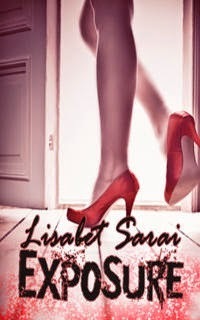
Exposure (An Erotic Mystery)
by
Lisabet Sarai
We’re shy afterwards. We hardly talk on the way back to my house, but his kiss when we arrive is heated and fervent. “Do you want to come in for a while?” I ask, wondering how it will feel to have a man in my bed after such a long time.
He shakes his head. “I’m done in,” he says with a mischievous grin. “Somebody really put me through the blender.” He kisses me again, more gently. “And maybe now you’ll get a good night’s sleep. I’ll call tomorrow.”
“Thanks, Jimmy. For everything.”
“Anytime,” he laughs, then turns toward his car.
I’m careful to lock the door behind me, but I’m still high from the evening’s events. Only when I come out of the shower do I notice anything strange. I open my lingerie drawer to get out my silk kimono, and find that all my lovely things are jumbled together, without any order. I was nervous and fussy while dressing, I remember, but I can’t imagine that I would have left my underwear in this state.
I check the other drawers. They are equally muddled. Most of the sweaters and jerseys are folded, but clumsily, and my usual organization by color and season is totally upset. Whoever rummaged through my clothing tried, without success, to disguise that fact.
Someone was in my house, while I was out with Jimmy. An intruder into my personal space. My haven! I sink down on the bed, shaking with mingled anger and fear at this violation. After a moment, I regain control of myself.
Someone had been here. Someone might be here still. I fish around in my purse for my Mace. I retrieve my haircutting scissors from the bathroom. Donning my terry robe, I creep into the hallway, a weapon in each hand.
Across the upstairs hall is my den and office, formerly my father’s bedroom. I stop and listen outside the door. All is silent. Reaching inside, I flick on the light. The room is empty. There’s no closet, nowhere to hide. But there are signs of disturbance. My desk drawer is open. My checkbook is on the writing surface as if someone had been reviewing the register. And my yellow pad, with my attempts at analyzing the events around Tony’s murder—I know that I left it on the desk. Now it’s gone. I search the rest of the desk, the cubbies and the file drawer. It’s simply not here.
Somehow I’m not surprised. I feel cold, cold and clear as arctic ice. Someone was here, someone who knows something about Tony’s death. Someone who thinks I know something, or have something that will lead me to the truth.
Shivering, I inch my way downstairs and check the front parlor. All is quiet and empty, though the burglar left his mark here, too. Knickknacks misplaced on the mantel. My father’s humidor left half-open.
Finally, I make my way to the kitchen. Here, there’s the clearest evidence: a tumbler with remnants of scotch, and a cigarette butt snuffed out in a saucer. By this point, it seems, my unwelcome guest didn’t care if he left traces.
The back door, I discover, is unlocked. I’m one hundred percent certain I didn’t leave it that way.
Carefully, keeping my body behind the door, I scan the yard. The light filtering from the kitchen windows is bright enough for me to see that there is no one in my little square of turf. It also shows me crushed tomato plants and bean vines torn from their trellises, clearly marking the intruder’s escape route.
At that point, my rage finally overwhelms my fear. I pour myself a finger of scotch and sit at the kitchen table, simmering in helpless anger and vowing some kind of revenge.
Then a horrible thought crosses my mind. Jimmy knew I would be out tonight. He was the only one who knew. Was it possible that he was involved in all this, somehow? Is it possible that smiling Jimmy might have betrayed me?
The balance shifts again. Shudders shake my body. Sitting alone under the fluorescent lights, gripping my drink, I am paralyzed by the realization that I don’t know who I can trust. If anyone.
Buy Links:
http://www.amazon.com/Exposure-Books-Erotic-Mystery-ebook/dp/B00BGTQS14/
http://www.amazon.co.uk/Exposure-Books-Love-Erotic-Mystery-ebook/dp/B00BGTQS14/
Published on September 17, 2014 00:00
September 16, 2014
WRITERS MUST READ BY RITA KARNOPP
 The other day I was chatting on the phone with a fellow writer and she said, “Who has time to read – I barely have time to write.” I can’t tell you how shocked I was. Actually I ‘had no words’ and let me tell you – that’s a rare thing.
The other day I was chatting on the phone with a fellow writer and she said, “Who has time to read – I barely have time to write.” I can’t tell you how shocked I was. Actually I ‘had no words’ and let me tell you – that’s a rare thing.I don’t know about you, but I’m always reading a book. I might not get it finished in record time, but I’m reading. If I’m watching a movie instead, I’m still thinking plot, characterization, and foreshadowing. Everything is about improving my skills as a writer.
Think about it this way. I’m positive dancers watch and study successful dancers. Novice singers study successful stars and learn by watching them what they are doing right. Well the same principle applies to writers. We learn how to write better, or what not to do, by reading other author’s books. If you’re not always trying to learn how to better your craft, you should stop right now and never write another book. Period!
Early on in my writing career I read the words, ‘Write what you know before creating that one-in a million Si-Fi best-seller.’ Why? You must learn the rules of fiction writing before you beak them. There’s a reason why beginner writers are told, ‘Start your book on chapter three, and I’ll bet that improves your story by 85%.’ As novice writers we somehow think we need to explain everything up front and later learn we can feed all this ‘great’ information into the story as it unfolds.
So, you might think – sheesh, Rita, you really got off the track here. LOL Well not really. How do we learn to tell stories that have value, distinction, suspense, sentiment, attitude, emotion, and at the same time be individualistic and fresh? By reading other author’s books. It’s true. While reading a book you might think to yourself, I would never have done that, or maybe you’ll think, that was tricky and I loved it.’
You should always have a book or eReader in your hand. I read in the doctor’s office, grocery lines, waiting for my turn at the bank, etc. Every lunch hour I read and guess what? I manage to read book after book. There’s no such thing as not having time to read . . . or write.
Published on September 16, 2014 01:00
September 15, 2014
IT’S A FACT BY RITA KARNOPP
 Getting your facts straight is as important as great pacing and dialog. All your reader needs to do is find is one fact they know is false – and they’ll put your book down faster than a hot handled-skillet.
Getting your facts straight is as important as great pacing and dialog. All your reader needs to do is find is one fact they know is false – and they’ll put your book down faster than a hot handled-skillet.Yes, editors catch some of these, but it’s not up to the editor to check for historical facts, gun specifics, or even when a ballpoint pen was invented. (The first patent for a ballpoint pen was issued on 30 October 1888, to John J. Loud, a leather tanner, who was attempting to make a writing instrument that would be able to write on his leather products, which then-common fountain pens could not.)
You should never consider referring to experts as ‘most’ or ‘the majority’ instead of presenting actual percentages or specifics. It’s more effective for the attorney in your book to say, “Medical experts will agree that in ninety percent of all rape cases. . .” instead of saying, “Most will agree that in a high percentage of rape cases. . .” Assumption is the root of all mistakes. It’s truly laziness to write in generalities than specific facts. Years ago it took a lot of time to find facts; it took book after book. Today there’s no reason for the lack of facts – the internet is at your fingertips.
Keep this in mind; if you make historic or general fact errors you can be pretty darn sure a reader won’t buy another one of your books. Why would you do this to yourself?
If you’re the kind of writer that doesn’t want to stop the flow while writing, mark areas you want to go back and check facts later. It’s as simple as that. You can expect an editor to catch many things while reading through your manuscript, but don’t rely on them to catch the simple things; spelling, lack of quotes, using wrong word, misspelled names, etc. You, the author should submit the best-written book you possibly can. Having said that, you also should never rely on your editor to make sure all your facts are correct. That’s your responsibility. If they catch a fact error, you’re one lucky author.So let’s consider the comment, “It’s fiction and I really don’t have to worry about specific facts. It’s all make-believe.” With that attitude you should stop writing. A reader knows a novel is fiction – they pretty much mean the same thing – but that doesn’t mean you can take liberties with historical facts. Just the opposite is true. If you want to create believable characters and plot the best way is to create believable scenes and facts surrounding your story.Here are some guidelines you should follow every time you write a story. . .· whether you set the facts straight as the story unfolds or · after you’ve finished the book and are working on your first edit and are smoothing all those rough edges. 1. Spell check.2. Double check all historical facts with multiple sources.3. Be specific; what kind of tree, flower, horse, treaty, etc.4. Write tight – not every bit of interesting information you’ve found must be included in your story.5. A pet-peeve of mine - watch those long sentences. I’ve read books where each paragraph has turned into a long sentence – with commas for pauses. Say what??
6. And finally, have your facts straight.
Published on September 15, 2014 01:00
September 12, 2014
Friday Freebits with Ginger #Frifreebits #blogshare
 Hooray...its Friday. Friday Freebits is something I have to look forward to since all other days seeem to blur into one since I've retired. I'm happy that I decided to do a short-story collection entitled, Discovery, and today I'm sharing six paragraphs from the last story in the book. Next week, we'll move on to something else. Just an interesting tidbit...this was one of the best sellers when they were printed individually.
Hooray...its Friday. Friday Freebits is something I have to look forward to since all other days seeem to blur into one since I've retired. I'm happy that I decided to do a short-story collection entitled, Discovery, and today I'm sharing six paragraphs from the last story in the book. Next week, we'll move on to something else. Just an interesting tidbit...this was one of the best sellers when they were printed individually.Paging Dr. Jones
With curled fists, [Dr. Jones] he rubbed the tiredness from his eyes and learned to leave, but Catherine stirred. "Is someone there?" Her question came out in a choked whisper, but still audible.
He brushed past the curtain and walked closer to her bed. "Yes, Ms. McGuire. It's me, Dr. Jones, remember?"
"Am I going to die?" Her voice trembled.
Unprepared for that question, he curled his fingers back into a fist, sending his nails biting into his palm. Damn her ex for putting him in this position. "Ah...Of course not. You're going to be fine. You might need a few minor surgical procedures, but we have to wait and see how your healing progresses. By my estimate, you'll make a complete recovery."
He hoped what he told he wasn't a lie.
He patted her hand. Now, you need to rest you voice and trust me and the hospital staff. I have another patient to look in on before my shift ends, but I'll be back in the morning. By then, you'll most likely have been moved to a regular room so someone can keep a closer eye on you. You're in good hands, here."
 So, Catherine has been beaten by her ex-husband and is in the hospital. How will Dr. Jones figure into her recovery, and is there is
Discovery
Catherine will make that will change her life?
So, Catherine has been beaten by her ex-husband and is in the hospital. How will Dr. Jones figure into her recovery, and is there is
Discovery
Catherine will make that will change her life?If you want to find out, you'll have to get your own copy of Discovery on my amazon page.
Published on September 12, 2014 00:00
September 11, 2014
FIRST-PERSON BY DAVID MORRELL #firstperson
Hi-jacked – good article – and great book about writing in the first person. J Rita
 Blockbuster novelist David Morrell’s expert view, the biggest con of writing in first person is that it traps us in our own viewpoint (or our protagonist’s viewpoint). The reader can know only what we know as we come to know it, see only what we see. This can limit the means in which you can tell the story and have it still ring true for your readers.
Blockbuster novelist David Morrell’s expert view, the biggest con of writing in first person is that it traps us in our own viewpoint (or our protagonist’s viewpoint). The reader can know only what we know as we come to know it, see only what we see. This can limit the means in which you can tell the story and have it still ring true for your readers.
Another con: When we select the first person we’re tempted to write as we speak. This can lead to undisciplined writing, potentially yielding rambling or flat, one-dimensional prose.
The tradeoff, though, can be authenticity. “There is no such thing as a third-person viewpoint in life,” Morrell explains. Which means you might say first person POV is the most true-to-life perspective from which to tell a story.
Another pro: First-person narrators can be unreliable narrators (and often the best ones are), leaving what happened open to interpretation—and, in the hands of a skilled writer, this can add amazing depth to a story, as evidenced so expertly in the best known works of Mark Twain and J.D. Salinger. Stories like theirs demand to be told in first person—in fact, Morrell points out they could not be effectively told in any other way.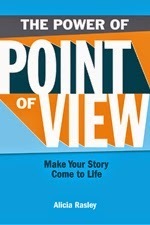
His key takeaway? Write in first-person only if you have a compelling reason to.
Want to strenthen your character’s Point-Of-View? Consider:
The Power of Point of View: Make Your Story Come Alive by Alicia Rasley
 Blockbuster novelist David Morrell’s expert view, the biggest con of writing in first person is that it traps us in our own viewpoint (or our protagonist’s viewpoint). The reader can know only what we know as we come to know it, see only what we see. This can limit the means in which you can tell the story and have it still ring true for your readers.
Blockbuster novelist David Morrell’s expert view, the biggest con of writing in first person is that it traps us in our own viewpoint (or our protagonist’s viewpoint). The reader can know only what we know as we come to know it, see only what we see. This can limit the means in which you can tell the story and have it still ring true for your readers.Another con: When we select the first person we’re tempted to write as we speak. This can lead to undisciplined writing, potentially yielding rambling or flat, one-dimensional prose.
The tradeoff, though, can be authenticity. “There is no such thing as a third-person viewpoint in life,” Morrell explains. Which means you might say first person POV is the most true-to-life perspective from which to tell a story.
Another pro: First-person narrators can be unreliable narrators (and often the best ones are), leaving what happened open to interpretation—and, in the hands of a skilled writer, this can add amazing depth to a story, as evidenced so expertly in the best known works of Mark Twain and J.D. Salinger. Stories like theirs demand to be told in first person—in fact, Morrell points out they could not be effectively told in any other way.

His key takeaway? Write in first-person only if you have a compelling reason to.
Want to strenthen your character’s Point-Of-View? Consider:
The Power of Point of View: Make Your Story Come Alive by Alicia Rasley
Published on September 11, 2014 01:00
September 10, 2014
A Page Straight From Jennifer M. Shaw-Dockery - #apagestraightfrom
 A Blessing Is In Sight
(A Poem from)byJennifer M. Shaw-Dockery
A Blessing Is In Sight
(A Poem from)byJennifer M. Shaw-DockeryBroken
I was broken into pieces
My life was positively upside down
I was confused and twisted
I didn't know what I had found
My heart was wounded
I couldn't feel no love
And
I prayed for help from above
I didn't know which way to turn
I had been treated so badly
I didn't want to keep getting burned
I couldn't feel anything
I couldn't even cry
I didn't know where to go
I didn't know why
Then Jesus stepped in to show me the way
Leading me through my troubles
Helping me start another day
I've been broken so many times
I couldn't shake that kind of pain
I couldn't show anyone how I felt
I didn't know what I would gain
I've been broken
Now I'm back together again
I knew I could escape it
I didn't know when
I'm so glad Jesus seen my hurt
And
He came to rescue me at that time
Because without His help I couldn't have lived
I would have been lost in my confused mind.
Book can be purchased at:
East Side Story
1108 Woodland Street
Unit B
Nashville TN 37206
Published on September 10, 2014 00:00
September 9, 2014
GENDER-SPECIFIC DIALOGUE BY RITA KARNOPP/ EXCERPT FROM LEIGH MICHAELS
 Being aware of gender-specific dialog is important no matter what genre you write. Dialog written in a female tone just doesn’t work if the intended speaker is male. Give that some thought.
Being aware of gender-specific dialog is important no matter what genre you write. Dialog written in a female tone just doesn’t work if the intended speaker is male. Give that some thought.Dialog must reflect the speaker – female, male, teen and even child. I’ve heard it said that it becomes more important when writing romance. I’m not sure why, since I truly believe no matter what genre you’re writing – the gender specific dialog must be correct or you’ll lose believability – then the trust of your reader.
It’s actually a good idea to have a male and female edit your book – the best way to catch errors in gender specific dialog.
Women and men think differently, so we all can understand why it’s so difficult to write convincing dialog for a character of the opposite sex. Let’s be honest, we might know who a guy thinks (and vice versa) but do we really? I tend to think not or so many writers wouldn’t be discussing this aspect of writing so often.
In an excerpt from OnWriting Romance by Leigh Michaels, the author discusses a starting point for developing the skill set essential to writing a best-selling romance novel.If You’re a Woman - Here’s how to make your hero’s dialogue more true to gender if you’re a female writer:· Check for questions. Men tend to request specific information, rather than ask rhetorical questions. If your hero’s questions can’t be answered with a brief response, can you rephrase them? Instead of asking questions at all, can he make statements?· Check for explanations. Men tend to resist explaining; they generally don’t volunteer justification for what they do. If you need him to explain, can you give a reason why he must?· Check for feelings. Men tend to share feelings only if stressed or forced; they’re more likely to show anger than any other emotion. They generally don’t volunteer feelings. If you need your hero to spill how he’s feeling, can you make it more painful for him to not talk than to share his emotions?· Check for details. Men tend not to pay close attention to details; they don’t usually notice expressions or body language; they stick to basics when describing colors and styles. Can you scale back the level of detail?· Check for abstractions. Men tend to avoid euphemisms, understatements, comparisons, and metaphors. Can you rephrase your hero’s dialogue in concrete terms?· Check for approval-seeking behavior. Men tend to be direct rather than ask for validation or approval. Can you make your hero’s comments less dependent on what the other person’s reaction might be?
If You’re a Man - Here’s how to make your heroine’s dialogue more realistic if you’re a male writer:· Check for advice. Women tend to sympathize and share experiences rather than give advice. Can you add empathy to your character’s reactions and have her talk about similar things that happened to her, rather than tell someone what he should do?· Check for bragging. Women tend to talk about their accomplishments and themselves in a self-deprecating fashion rather than a boastful one. Can you rephrase her comments in order to make her laugh at herself?· Check for aggressiveness. Women tend to be indirect and manipulative; even an assertive woman usually considers the effect her statement is likely to have before she makes it. Can you add questions to her dialogue, or add approval-seeking comments and suggestions that masquerade as questions?· Check for details. Women notice styles; they know what colors go together (and which don’t); and they know the right words to describe fashions, colors, and designs. Can you ramp up the level of specific detail?· Check for emotions. Women tend to bubble over with emotion, with the exception that they’re generally hesitant to express anger and tend to do so in a passive or euphemistic manner. If you need your heroine to be angry, can you give her a really good reason for yelling?· Check for obliviousness. Women notice and interpret facial expressions and body language, and they maintain eye contact. If you need your female character to not notice how others are acting, can you give her a good reason for being detached?
Writing Realistic Dialogue: Exercises1. Eavesdrop (politely) as real people talk. How do two women speak to each other? How do two men speak to each other? How do a man and a woman speak to each other?2. Can you guess the nature of each relationship? For instance, do you think the couple you’ve listened to is newly dating or long-married? On what evidence did you base your opinion?3. Read your dialogue aloud. Unnatural lines may hide on the page, but they tend to leap out when spoken.4. Listen to someone else read your dialogue aloud. Better yet, get a man and a woman to read the appropriate parts. How do the lines sound? How do they feel to the speakers?
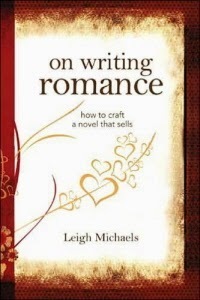 How to Craft a Novel That Sells - By Leigh Michaels - More romance titles are published every year than any other genre and more writers try writing romance first because the demand for the genre is so much greater than any other. For those new to the genre or writing, this book provides a starting point for developing the skill set essential to writing a best-selling romance novel.In This Book You'll Learn:· Detailed descriptions of more than 20 subcategories within the romance genre · Tips for avoiding clichés · How to create the perfect romantic couple · Guidelines for drafting those all-important love scenes
How to Craft a Novel That Sells - By Leigh Michaels - More romance titles are published every year than any other genre and more writers try writing romance first because the demand for the genre is so much greater than any other. For those new to the genre or writing, this book provides a starting point for developing the skill set essential to writing a best-selling romance novel.In This Book You'll Learn:· Detailed descriptions of more than 20 subcategories within the romance genre · Tips for avoiding clichés · How to create the perfect romantic couple · Guidelines for drafting those all-important love scenes · Submission information for breaking into the genre
Published on September 09, 2014 01:00
September 8, 2014
REVIEW WITH CLASS by Rita Karnopp #reviewing
 There’s no reason you can’t review a book with class and professionalism. A book review is a description, judicious analysis, and an evaluation of the quality, gist, and impact of a book. It’s so important to realize a book review is not a retelling. It’s not a book report or a summary.
There’s no reason you can’t review a book with class and professionalism. A book review is a description, judicious analysis, and an evaluation of the quality, gist, and impact of a book. It’s so important to realize a book review is not a retelling. It’s not a book report or a summary.A book review should focus on the book's purpose and content. How did the book affect you – the reader? You should evaluate the strengths and weaknesses of the how well the author told his/her story. Your review should include a statement of what the author has tried to do, evaluate how well he/she has succeeded, and present evidence to support your appraisal.
There’s no right or wrong way to write a book review. Face it, book reviews are highly personal and reflect the opinion(s) of the reviewer. Your review can be as short as 50-100 words, or as long as 1500 words, depending on the purpose of the review.
I might add a personal note here – “If you can’t say something nice, maybe it’s best left unsaid.” If you truly dislike a book, that’s okay, not every book we read will be #1. But chastising a book in a review could make or break an author. Is that your intent? I would hope not. If I don’t care for a book I’ve read, I let it go. It’s not necessary to berate or trash the book or the author.
The following is a simple guide for writing a book review that works. 1. Write a statement including basic information about the book: title, author, type of book.2. Write a sentence indicating point of view and genre.3. Evaluate the quality of the writing style by using some of the following standards: consistency, clarity, creativity, strength, pithiness, development, and even fluidity.4. Ask yourself does the story reach the intended audience?5. To me the most important question to ask yourself – then review from your heart – “how did this book affect me?” Did you have preconceived notions about the subject matter and now they’ve changed or perhaps they’re reinforced due to this book?6. Did the book realize its goal(s)?7. End your review with the oh-so-important, ‘would you recommend this book to others’? Why?
Remember, your review should include a brief summary, analysis, and comment on the book’s content. Include your general conclusions. If you feel strongly to make a statement, use specific references and quotations to support them. And always end with a comment of support and referral
Published on September 08, 2014 01:00
September 5, 2014
Friday Freebits with Ginger Simpson #frifreebits
 Welcome to Friday Freebits and six paragraphs from my short story collection,
Discovery
. I love short stories, and although warned they don't sell well, I remember subscribing to the Condensed Reader's Digest books and loving the opportunity to enjoy a short read. I hope you'll be enticed to want to read more. This is the second to the last story in this book, so after next week, I'll begin another book. Until then, enjoy today's six:
Welcome to Friday Freebits and six paragraphs from my short story collection,
Discovery
. I love short stories, and although warned they don't sell well, I remember subscribing to the Condensed Reader's Digest books and loving the opportunity to enjoy a short read. I hope you'll be enticed to want to read more. This is the second to the last story in this book, so after next week, I'll begin another book. Until then, enjoy today's six:Set up: Sarah and Melinda are their mother's room after the woman's funeral. Melinda is sitting on the edge of the bed and Sarah in her mother's favorite chair.
The Forget-Me-Nots
Sarah stood and walked to the ornate wooden box on the dresser. She turned, her hand on the top. "Would you mind if I went through Mom's jewelry and picked out a special keepsake?"
"Of course not. Take whatever you want. We're not going to be like some families who develop claws and fangs over a loved-one's personal belongings."
Melinda peered up at Sarah. "When did you get so tall? Seems like just yesterday you were ten and now your twenty and in college. Where has time gone?"
Sarah shook her head. "I don't know. At times, I long to be a kid again, then Mom could spoil me rotten. I always like being the baby of the family."
The doorbell rang. Mel stood, patted Sarah's arm and meandered out toward the living room. Sarah picked up the small mahogany chest that matched the other furniture pieces in the room and walked back to the rocking chair and sat. Tears stung the back of her eyes.
She fingered the scalloped edges around the top and the gold plate being the initials "CP." When she opened the box, her mother's favorite scent wafted out, stirring a wealth of memories. Sarah doubted she could ever smell lavender again and not think of Mom. The contents sparkled in the lamplight.
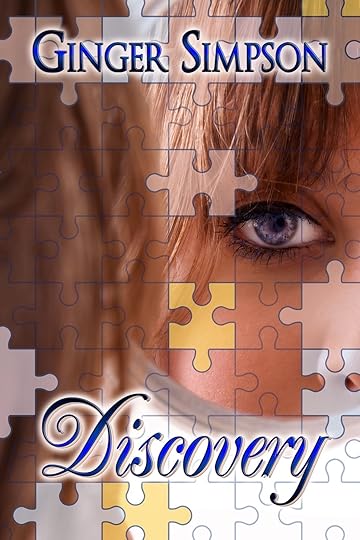 So, what will Sarah "discover" in the jewelry box? Want to know more....yep, you guessed it. I'm a tease and you'll have to find your own copy on my amazon page: http://www.amazon.com/author/gingersimpson.
So, what will Sarah "discover" in the jewelry box? Want to know more....yep, you guessed it. I'm a tease and you'll have to find your own copy on my amazon page: http://www.amazon.com/author/gingersimpson.If you wonder why there are no links, I've decided to keep this as a permanent feature for my own use. I hope you'll continue to follow me each Friday.
Published on September 05, 2014 00:00



